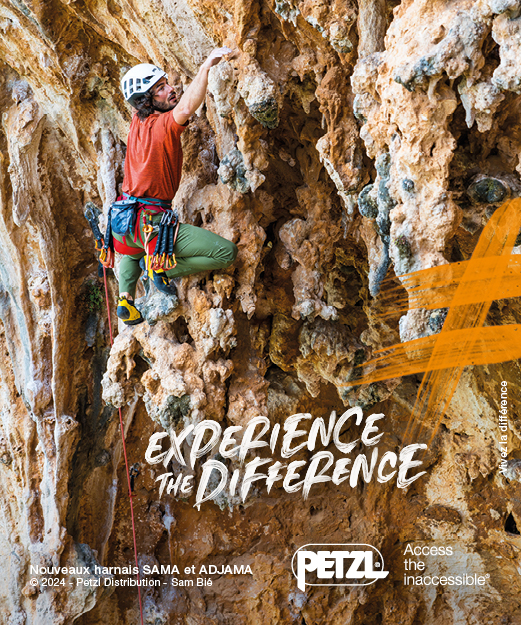Climbing. The Power of Strength… at any age!

In climbing, strength is an essential component of performance. Anyone on the quest for their next boulder or route can easily verify this. Of course, strength is not the only factor. This helps understand why, in climbing, one can perform well into a relatively advanced age. However, every aging climber faces a harsh physiological reality. With age, maximum strength tends to decrease. Several questions arise: Can this inexorable process be temporarily halted, or at least slowed down? Can we hope, with appropriate training, to retain some of the strength levels that once made us proud? Or should we shift our efforts to other trainable factors and focus on different qualities? These are the questions we invite you to explore today.
Evolution of Strength with Age
The decrease in muscle mass (or sarcopenia) with age is well-documented for the general population. It begins in the third decade, and from the age of 40, some studies estimate a ± 5% loss of muscle mass every 10 years, accelerating beyond the age of 60. This evolution primarily affects the muscles of the lower limbs and is associated with a decline in physical activity. Of course, this phenomenon represents a challenge from a general health perspective, as the decline in strength ultimately leads to a loss of autonomy.

Many climbers experience this decline in strength, and its inevitable nature, although slowed in athletic populations (as has been shown), can be discouraging. Hence, one can find wise recommendations online to stop bouldering, redirect one’s practice, especially towards climbing on less steep and more technical profiles. All of this seems to be stamped with common sense. However, it is essential to remain more optimistic, especially when considering the study conducted by Gabriel Nasri Marzuca-Nassr and colleagues, published in 2023 in the “International Journal of Sport Nutrition and Exercise Metabolism.”
Strength: Do we still progress at an advanced age?
State of knowledge
Several studies have shown that appropriate training leads to hypertrophy and increased strength in already older individuals (between 65 and 75 years). However, for even older individuals (over 80 years), most studies conclude a “blunted” muscular response to training. This less favorable adaptation can be attributed to various causes, including enzymatic, neural, hormonal, or inflammatory factors.
The significant interest of the study conducted by Nasri Marzuca-Nassr is that it examines training responses for very old populations and compares them to responses observed in younger populations. This had not been done before. The protocol developed by the research team involved two groups of individuals, aged between 65-75 years and over 85 years, training three times a week for 12 weeks. The exercises targeted the whole body, with exercise intensities ranging from 60 to 80% of the one-repetition maximum (1RM) throughout the protocol.

Influence of strength training in elderly individuals
At the end of this intensive period, here’s what the researchers observed: Certainly, individuals over 85 still had smaller muscle volumes than those aged 65-75, and lower performance levels. However, in both populations, there was an increase in quadriceps diameter and, more broadly, an increase in upper and lower body strength. Moreover, there was no difference in adaptation between the two populations!
Regarding strength improvement, there are significant interindividual differences, as evidenced by standard deviations. There are also differences in progress among different muscle groups. Progress is much more pronounced in the lower limbs (up to 50%) than in grip strength or pulling strength (4.4% and 23%, respectively, in the older population). To explain the progress and differences observed with previous study results, the researchers highlight the volume and intensity of the work performed. In this study, individuals trained for 12 weeks, three times a week, on exercises with intensities ranging from 60 to 80% of the one-repetition maximum voluntary force!

Bouldering practice serving route climbing. © Coll. Y. Baechler
Strength decline: Are athletes protected?
We find some answers in the article by Latella C and his collaborators: “Athletes to Determine Strength Adaptations Across Ages in Males and Females: A Longitudinal Growth Modelling Approach,” published in 2023 in the Sports Med journal. It is interesting for several reasons: it is a retrospective and longitudinal analysis that examined a large amount of data from athletes of both sexes and different ages. These athletes also trained multiple times a week. All of this gives the study considerable statistical power. Another interesting factor is that this study concerns a strength sport, as climbing is. Although the goals of powerlifting and climbing are different, as are the morphologies of the athletes (although increasingly, we observe quite “massive” specimens on bouldering mats ;-)).
What is shown is that progress does diminish over time. This is due to factors related to age. However, the specificity of the physical practice being considered must also be taken into account. The number (diversity) of movements is very limited in powerlifting. As experience and adaptation to these movements increase, it becomes increasingly challenging to reach another level. However, the study primarily demonstrates the positive role of continuous strength training, regardless of age. Regular strength training, as long as it is not minimal, is likely to significantly attenuate the age-related decline in strength. It is thus an encouragement to continue in this direction during our training sessions.

How to approach strength training while being old?
Reflect on your practice.
When looking in detail at the evolution of muscle tissue with age, it is apparent that fast fibers, the most powerful ones, are affected first. Their number and volume decrease, and switches can even occur, meaning the transformation of fast fibers into slower ones. Applied to climbing, this suggests that, as one ages, it may be useful to reconsider our climbing locations and styles and possibly evolve them. For enthusiasts of bouldering or ultra-short and powerful routes, this clearly means choosing slightly longer passages (traverses) or routes that require more endurance of strength than explosive strength. And since all our tissues age, not just muscles, it also becomes necessary to question grips and types of movements to limit the risk of injuries.
Finally, it is essential not to disrupt the training or practice forms that have been adopted for a very long time. For a climber whose training has been primarily in bouldering or on cliffs for decades, adding sessions of “pure” muscle strengthening can only be envisaged very gradually.

How to plan?
From a certain age, it can become increasingly challenging to balance a demanding family life, work, or other interests, or simply social life. The challenge is to sanctify climbing or training sessions. They might be less frequent than before or desired, but this regularity will be a valuable factor for future progress.

On the contrary, a common mistake is to go all out whenever there is free time to make up for lost time. Unfortunately, this strategy generates breaks in adaptation and proves to be the shortest path to injury, undoubtedly the best way to waste time. In this planning effort, one can also be constrained by tight schedules, which require short sessions. This confronts us with a certain form of contradiction. Strength training requires relatively long and careful warm-ups. We know that doing three push-ups or three hangs at the end of a session will not be enough to progress, yet time is limited.
A clever way to overcome this difficulty is suggested by Laurent Vigouroux and Clément Lechaptois in their book “La Force.” It involves adopting an “ecological” planning framework, in this case called the “points permit,” where you set exercise goals to be achieved per week. This way, you can easily monitor the work done and quickly adjust it based on your fatigue levels.

Targeting useful qualities for training
Maintaining strength is essential, as we have seen. But for progression, it is also useful to address as many factors contributing to climbing performance as possible, those that may have been neglected or where there is still significant room for improvement.
- Among these, technical skills is an underestimated source of progress. Improving coordination, refining balance or movement sensations, enhancing precision in placements are all avenues to continue exploring and pushing.
- Mobility work is also often overlooked. Yet, this quality tends to dramatically reduce with age if not taken care of. However, it is essential because it alone allows us to exert high levels of force on supports located far from the body’s axis or in unusual positions. In practice, this does not require a considerable time investment. 3 to 4 stretching sessions per week, even just 10 minutes, targeting the two “belts,” shoulders and pelvis, may be sufficient to maintain mobility levels.
- Regarding strength training itself, working on antagonist muscles, on body regions that have been less solicited so far (because priority was given to forearms, arms, and shoulders), is also a progression vector.
- Finally, even if we move out of the physical sphere, training mental and cognitive factors requires little energy and holds good prospects for progress. Better memorizing and visualizing your current project, for example, will save you a lot of time and energy for its realization.

Strength training modalities
Regarding strength itself, age invites a reconsideration of training modalities and tools used. It is clear that maintaining or even progressing in strength requires working at an intensity sufficient, exceeding 70% of one’s maximum capacities. However, certain tools or modalities may take up less space with age. For example, it may become less relevant to consider the traditional plyometric sessions on the Campus board. Moreover, considering the evolution of our practice (as mentioned earlier), is it judicious to perform two-handed dynos if this type of movement is not found in the routes we climb?

Hygienic Aspects
Finally, aging has an impact on more global factors that need to be considered. Sleep may change: shorter sleep onset phases, more frequent light sleep fractions, changes in the biological clock. Also, our metabolism naturally slows down with age, generally accompanied by a tissue redistribution. Namely, a decrease in muscle volume in favor of fat mass. Therefore, while strict asceticism may not make much sense, it is still necessary to control your diet to maintain a stable weight. Every additional kilogram to carry also increases the mechanical strain on the fingers and the risk of injury.

Conclusion
Vanitas vanitatum et omnia vanitas.
This is how the Book of Ecclesiastes concludes. Its author, after exploring every aspect of earthly life, concludes that everything is vanity and a chasing after the wind. Every aging climber faces a dilemma. How to perpetuate oneself as a climber, how to continue embracing a performance-oriented practice while one’s abilities deteriorate? If Chateaubriand finds the overcoming of this dilemma in religion, there are undoubtedly other paths to explore for us climbers. Firstly, despite natural evolution, one can continue climbing for a long time and even perform quite late, if one has good health. Moreover, the concept of performance can be redefined and no longer reduced to a simple climbing grade. Finally, as the studies referred to in this article attest, strength training, provided sessions are adapted to the evolution of recovery capacities, can still lead to progress. And therefore remains the best defense against aging.








